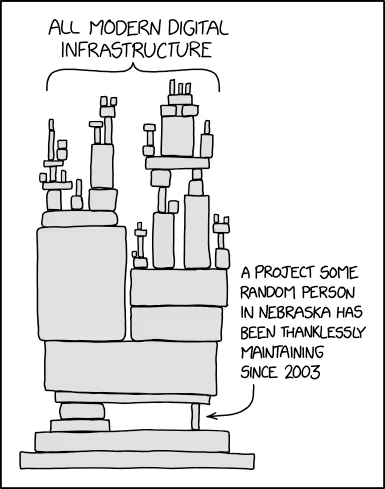'Debt' is a loaded word, indicative of poor resource management and lack of discipline.
Debt, we think, is a problem that needs solving as soon as possible if we want to thrive, whether we're talking about individuals, governments, or any other types of organization.
However, few would argue that taking on a financially manageable mortgage to buy a house is a bad decision. Similarly, a business loan to finance start-up costs or useful equipment can drive significant revenue long-term. Perhaps that's why we refer to 'mortgages', 'loans', and 'financing' and avoid the awkward 'D' word altogether.
So it is with technical debt management. Debt \= bad. We must avoid it at all costs.
But, what happens if we shift our perception of technical debt (bad) to a technical loan (a strategic decision for short-term advancement, with a well-researched plan for repayment)?
Accepting a level of technical debt might be an inevitability as the code we write and the tools we use get exponentially smarter. You can fight against it, or you can see this debt as something to be managed effectively for short and long-term gain - especially when using the most up-to-date AI development and testing tools.
Is 2025 the year you stop fearing technical debt and learn to manage it properly? Here's what to consider, and how to get started.
Technical Debt: What Does it Mean in 2025?
The idea of technical debt (sometimes known as 'software development debt') was first articulated in 1992 by Agile pioneer Ward Cunningham. Here's what he said about the concept a few decades back:
"Shipping first time code is like going into debt. A little debt speeds development so long as it is paid back promptly with a rewrite...The danger occurs when the debt is not repaid. Every minute spent on not-quite-right code counts as interest on that debt. Entire engineering organizations can be brought to a stand-still under the debt load of an unconsolidated implementation, object-oriented or otherwise."
In other words, quick fixes become increasingly difficult to repair the longer they are left unfixed. This is because as time goes on, it becomes more likely that future development work has to do some pretty unorthodox stuff to accommodate these quick fixes. The system becomes increasingly complex and fragile, and the risk of large-scale breakage increases.
Technical debt is still a massive issue today. More organizations than we think are propped up by decades-old systems, or codebases full of workarounds and never-quite-fixed temporary shortcuts. As this comic illustrates beautifully:

(Source: xkcd: Dependency)
Just ask Southwest Airlines, whose accumulated technical debt in its crew scheduling systems led to16,00 stranded flights and $1bn in financial losses back in 2022. The risks posed by technical debt certainly haven't disappeared.
But Technical Debt Has Become Significantly Easier to Manage
Here's the thing. Ward Cunningham's concept of technical debt was informed by a world in which shipping code - and finding/fixing bugs after the fact - was a weeks-long process. It's just not anymore.
Releasing quick-fixed code in the early 90s, when your QA team would need to spend weeks fixing issues(with a possibility that the work would get deprioritized, ignored, and destabilize your entire codebase in the long run)? Incredibly risky.
Releasing quick-fixed code now, knowing you can redeploy in a matter of hours and complete full test runs in days, with minimal time commitment? Potentially a no-brainer, given how crowded the digital landscape is, and how many competitors you have snapping at your heels.
Easier Payback \= More Clearly Defined Advantages
Unless you're building a completely new product category, the chances are your team is under ever-increasing pressure to build fast, get to market first, and stand out against a field of competitors that's more crowded than ever.
If you can resolve a lot of the code debt from a new release in a couple of days, using AI-enabled find-and-fix and optimization tools, you neutralize a lot of the risk involved in accruing technical debt.
This means that:
- Taking some shortcuts to quickly launch an MVP or beta product before committing to a full launch
- Releasing critical features quickly to beat a competitor to market, or keep a project on track to meet tight deadlines
- Launching your first product to drum up investor interest, or to gain user insights for your product ahead of a funding round
Are all inherently less risky and more attractive than before. If you can leverage this, and manage your code debt effectively, opportunities await.
Technical Debt: Time To Embrace It With a Solid Management Strategy
In 2025, our most up-to-date technologies are evolving faster than ever. Unlessyou are updating all your systems, all the time, it's very easy to accrue technical debt - and that's ok.
The classic 'scare statistic' is that chasing technical debt eats up around 30% of IT departmental budgets each year. By implementing the right technical debt management processes, you'll be able to bring that number down - but isn't absolute zero a pipe dream, given how fast everything is evolving?
It's time to accept technical debt as a fact of writing code in 2025, and take a proactive approach to managing it.
Building a Successful Technical Debt Management Strategy: 4 Key Steps
1. Set Clear Objectives and Priorities
Firstly, know what you're dealing with. Document every instance of your organization's technical debt you can find. Time consuming and potentially alarming? Definitely - but it will all be worth it in the long run.
Once you know where you stand, it's much easier to build a list of immediate priorities and longer-term projects. Here are a few steps to get you going:
- Identify any quick wins and address these first - any low-cost, high-impact production-based issues go straight to the front of the queue.
- Move onto any low-cost, low-impact issues - their impact will add up, even if they seem relatively harmless individually.
- Create longer-term schedules for fixing more complex issues. You won't fix your legacy architecture time bomb in one sitting - set some milestones to keep things moving.
- Code-level problems like bugs and updating legacy code can be handled incrementally, with AI taking on some of the workload.
2. Build a Timeline to Address New Technical Debt
If you want to keep your technical debt at a manageable level, you need to avoid new debt spiraling as you're addressing your existing debt.
Avoid seeing this as a standalone activity - instead integrate debt management into your everyday workflows by:
- Phasing debt management into each sprint, with 10-20% of resources each time dedicated to managing or reducing any technical debt created.
- Building a roadmap with key debt management milestones - you might allow a certain amount of technical debt to speed an MVP to market whilst planning to address this before a full launch, for example.
- Scheduling 'debt sprints' where you foresee a sudden build up of technical debt.
- Integrate incremental code updates and improvements into your engineers' everyday activities.
- Test early and often - use Shift Left methodology to run testing and development concurrently, so that issues get picked up when they are easier and cheaper to fix.
3. Secure the Resources You Need
The easiest way to do this is by reserving a specific percentage of your sprints for technical debt reduction. You should allocate these updates each quarter at least, so that there's no excuse to get stuck on older versions and build your app around an outdated tech stack.
4. Use New Technologies to Reduce Your Workload
If the steps above seem like a lot of work, we have good news. Automation and AI can significantly reduce the time you need to manage technical debt.
You'll need to invest human hours in the strategic decisions behind managing your technical debt - but when it comes to day-to-day management tasks, the right tools can make things significantly easier.
Use AI and automated tools to:
- Integrate automated checks into your CI/CD pipeline to enforce standards and prevent new debt piling up.
- Use code analytics tools to track useful metrics, such as cyclomatic complexity, duplicated code, and technical debt ratio.
- Invest in AI testing to reduce the amount of time spent managing code debt, eliminate development/testing silos, and increase engineers' ownership of their own code.
Why AI Testing Can Help Managing Code Debt
AI testing can cut out the majority of time needed to test code, identify bugs, and release updates. As a result, your engineers can integrate technical debt management into their everyday workflows seamlessly.
This makes it very easy to manage code-based incremental technical debt effectively. Your engineers can keep chipping away at technical debt in the background, whilst reserving the majority of their time for other tasks.
No need for expensive, silo-inducing QA teams - your engineers test the code that they create (which reduces the build up of technical debt in itself, because engineers that don't test code tend to write code that's hard to test).
AI-based technical debt tools can offer:
- AI 'agents' that can find and fix bugs on their own, with no human input required.
- Natural-language processing that eliminates the need for code whilst building automated tests.
- Self-healing tests that minimize the need for test maintenance.
- Seamless integration with key technical debt management software and workflows, including CI/CD providers and project management tools.
Momentic: Your Ticket to Successful Technical Debt Management?
Momentic makes it 3x faster for our team to write and maintain end to end tests.
Alex Cui, CTO, GPTZero
We'd love to see if Momentic's AI testing tools could help your engineers minimize the time spent reducing technical debt and maximize focus on valuable project work - no clunky external QA team needed.
If, like Alex and his team, you're keen to save over two thirds of the time you spend on key testing processes, why not schedule a conversation with our team?
.png)

